The Clones affray, 1922 – massacre or invasion?
Published in 20th-century / Contemporary History, Features, Issue 3 (Autumn 2004), Revolutionary Period 1912-23, Volume 12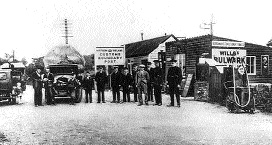
A Northern Ireland customs post near Newry c. 1922. Such posts became virtual armed camps with the IRA’s increased activity along the border in early 1922. (PSNI)
On Saturday 11 February 1922 a gun battle at a County Monaghan railway station resulted in the deaths of four Ulster Special Constables, the local IRA commandant and the wounding of numerous other combatants and civilians. What really happened? Robert Lynch investigates.
The events at Clones were inevitably interpreted in radically different ways by both unionists and nationalists, occurring as they did amidst the establishment of two new administrations in Ireland. For unionists the Clones incident was a ‘massacre’ ruthlessly planned and carried out by the IRA. Nationalists tended to paint the Specials’ arrival in Clones as akin to some form of invasion of Free State territory, exacerbated by the brutal and unprovoked murder of the local IRA commander. What was the truth behind these conflicting claims?
Collins’s policy—to make partition unworkable
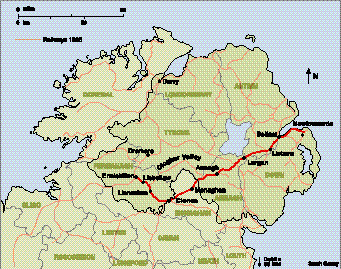 What later became known as the ‘Clones affray’ was an indirect consequence of Michael Collins’s confused early attempts to impede the establishment of Northern Ireland. From the signing of the Anglo-Irish treaty in late December 1921 until the outbreak of civil war six months later Collins would use every means at his disposal, both military and political, to make partition unworkable. The first test of his new policy came about almost by accident. On 14 January 1922, the same day that the Provisional Government was established in Dublin, senior officers of the IRA’s Monaghan-based 5th Northern Division, including the divisional commandant Dan Hogan, were arrested at Dromore, Co. Tyrone, en route to Derry City. Ostensibly they were journeying as part of a Gaelic football team to take part in the Ulster championship final. In reality this served as a front for a reconnaissance mission aimed at eventually releasing three IRA men imprisoned in Derry Gaol who were due to be hanged on 9 February. Later Eoin O’Duffy, chief-of-staff of the pro-treaty IRA, indicated that he believed the Clones affray was due principally ‘to the evident intention of the Northern government to hang the three Derry prisoners’ and the anger and instability this caused in border areas.
What later became known as the ‘Clones affray’ was an indirect consequence of Michael Collins’s confused early attempts to impede the establishment of Northern Ireland. From the signing of the Anglo-Irish treaty in late December 1921 until the outbreak of civil war six months later Collins would use every means at his disposal, both military and political, to make partition unworkable. The first test of his new policy came about almost by accident. On 14 January 1922, the same day that the Provisional Government was established in Dublin, senior officers of the IRA’s Monaghan-based 5th Northern Division, including the divisional commandant Dan Hogan, were arrested at Dromore, Co. Tyrone, en route to Derry City. Ostensibly they were journeying as part of a Gaelic football team to take part in the Ulster championship final. In reality this served as a front for a reconnaissance mission aimed at eventually releasing three IRA men imprisoned in Derry Gaol who were due to be hanged on 9 February. Later Eoin O’Duffy, chief-of-staff of the pro-treaty IRA, indicated that he believed the Clones affray was due principally ‘to the evident intention of the Northern government to hang the three Derry prisoners’ and the anger and instability this caused in border areas.
With the split in the IRA ranks over the treaty now growing alarmingly, Collins seized on the opportunity these arrests provided for demonstrating his new hard-line policy to those who had lost faith in his republican credentials. On the night of 7–8 February, by way of retaliation, the IRA raided across the border in large numbers, concentrating particularly on the Clogher Valley in the south of County Tyrone and the Enniskillen area. This coordinated attack involved carloads of Monaghan, Longford and Leitrim IRA men who, after cutting local communications and burning various properties, kidnapped over 40 local unionists and fled back across the border into County Monaghan.
The kidnapping raids had been planned by a shadowy new body called the Ulster Council, which was established by Collins in early January 1922. Its aim was to coordinate IRA activity in the six counties and along the border. This highly secretive organisation acted under the auspices of the Irish Republican Brotherhood (IRB), of which Collins was president of the supreme council. He was joined at its head by Eoin O’Duffy and Richard Mulcahy, and it was this IRB triumvirate that would be responsible for organising the extensive IRA attacks in the north over the following six months.
Clones at the centre of a political storm
Collins’s determination to halt the executions of the Derry prisoners had gone even further, sending two of his ‘squad’ to England to assassinate the two hangmen who were to execute the prisoners; however, they had already left for Ireland. At this point Clones became the centre of frenetic IRA activity. The town itself contained the 5th Northern Divisional headquarters and lay within a few miles of both the Tyrone and Fermanagh borders. Its strategic position meant also that it had become the headquarters of the Ulster Council, within easy reach of both Aiken and MacEoin’s commands in Armagh and Longford respectively. Both geographically and politically Clones lay at the centre of a political storm that would soon erupt on its very doorstep.
While diplomatic efforts to release the ‘Monaghan footballers’ continued apace, the local situation became extremely tense. In response to the kidnappings, Specials poured into border areas. Bridges were blown and all but major roads were mined or trenched. The Specials set up checkpoints at the remaining border crossings and local farms were abandoned by their owners. A stalemate ensued, and both sides exchanged fire across the now-fortified border areas. It was against this backdrop that at around 5.15pm on Saturday 11 February the ill-fated train containing the Specials arrived at Clones station. The party itself consisted of nineteen uniformed ‘A’ Specials led by Sergeant William Dougherty. Six of the constables were armed. They had left Newtownards via Belfast earlier in the day. Their final destination was Enniskillen, where they were to reinforce the local USC platoons as part of the wider build-up of forces along the Monaghan border. It certainly was a provocative route to choose, especially when one considers that the British army had evacuated Clones only days before to concentrate at the Curragh and Dublin. The clumsy choice of route did cause some consternation after the event although no evidence exists to suggest that it involved any sinister motives, some kind of administrative blunder being the favoured interpretation.
On arrival at Clones, Sergeant Dougherty gathered the six-man armed party together on the platform. The rest of the men made their way to the buffet. One or two others strolled about the station, mingling with civilians and kicking their heels until the train arrived. No IRA men appeared to be present at the station, although Constable John Guiness recalls noticing ‘some suspicious looking young men on the platform all the time’. It is likely that at least one of these young men was responsible for alerting the IRA to the presence of the Specials and thus inadvertently turning an innocent journey into a tragic confrontation. Meanwhile, in the IRA’s divisional headquarters at the workhouse in Clones, battalion commandant Matt Fitzpatrick had recently arrived with some other officers. Fitzpatrick responded rapidly to the news of the Specials’ arrival. Quickly arming themselves, he and three other officers leapt into a car and headed for the station, informing others to gather more men and follow him up as soon as possible. They sped off, covering the short distance to the railway station within minutes.
‘They have it in for you boys’
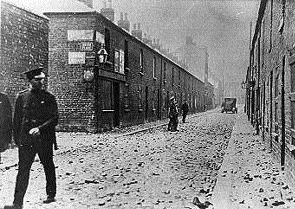
Police on patrol in the York Street area of Belfast c. 1922 after a night of rioting. (PSNI)
Back at the station the Specials were preparing to leave. The Enniskillen train had arrived and some of the party had taken their seats while others dawdled on the platform and drifted towards their carriages. As the last half-dozen or so Specials climbed aboard the train, Special Constable Peter Martin recalls that one of the railway porters came to the door of his compartment and, pointing to the recently arrived IRA officers, said ‘They have it in for you boys’. Fitzpatrick and his three officers had just entered the main door of the station. Revolver in hand, he walked to the engine to stop the train from leaving. IRA lieutenant Patrick Rooney recalls the events as follows:
‘When we got on the platform we turned towards the engine as the train was due to start. We then saw the engine was not attached. We turned back towards the rear of the train. Commandant Fitzpatrick was leading the men down the platform. I was behind him. On reaching the first compartment where there were Specials the commandant shouted ‘Hands up! Surrender’, immediately there was a shot from the compartment and Commandant Fitzpatrick dropped dead in front of me.’
It was never established who fired this fatal shot, and the issue of which side had initiated the violence would become the subject of bitter argument over the following weeks, with both sides claiming vociferously that they were the innocent victims of an unprovoked attack. However, what followed these few disputed seconds is more certain. Fitzpatrick, shot in the head with a single bullet, fell dead between two carriages. Immediately the situation exploded into chaos. The IRA, now numbering around twenty, dived for cover and a hail of bullets was fired at the Specials’ carriages. An anonymous witness relates the chilling scene as follows:
‘After we had been seated about two minutes shots suddenly rang out, about six being fired into our carriage in quick succession, one of the bullets flashing across my face and grazing my hat. I could hear shots being discharged all over the train mingled with the yells and screams of the men in the other carriages. I heard one man appeal for mercy, and another call for his mother.’
Frederick Browne of Enniskillen recalled seeing several individuals jumping out of the train on the opposite side, only to be held up by an armed IRA man who forced them back into the carriages where the main attack was taking place. Hector Jeffers, a trooper in the Inniskilling Dragoons, who was in a compartment with one of the Specials, stated:
‘I heard the thud of a bullet coming through the woodwork of the carriage, a few minutes after this the special constable said ‘I am hit’, and when I looked round he was bleeding from the mouth. His eyes closed and I think he died in a few minutes.’
The scene on the platform was chaotic. Some of the Specials caught in the open attempted to surrender, only to be raked with machine-gun fire, whilst others either fled or returned fire from the wrecked carriages.
By all accounts Constable Robert MacMahon was the first Special to be killed. Three others were to follow: Sergeant Dougherty and Constables James Lewis and William McFarland. The train had been riddled with bullets, concentrated mainly on carriage 85, where the Specials were located. Countless civilians were wounded, including Patrick Crumley, the former nationalist MP for South Fermanagh. Eight other Specials were wounded to varying degrees. Constable John Cummings was hit by machine-gun fire below the waist and as a result lost his right leg. Constable George Lendrum had six machine-gun bullets in him but somehow survived. Others escaped unscathed, although most, like Albert Lyttle, were very lucky. His cap was knocked off by a bullet and another passed harmlessly through his tunic.
The IRA, now arriving in large numbers, gave orders for everybody to leave the train. The civilians were separated from the remaining Specials, of whom only three were unwounded. An anonymous witness related his view of the terrible aftermath:
‘A number of passengers were ordered to clear the dead and wounded out of the carriages. The victims, numbering upward of 20, were carried from carriages and laid prostrate in the ladies’ waiting room. The passengers having completed the gruesome work of clearing the carriages, returned with their faces, hands and clothing saturated with blood.’
The train itself left 45 minutes late, around 6.30pm. Despite the IRA allowing the civilians to continue their journey, it appears that only a few took this opportunity. In Clones itself IRA units from counties Monaghan, Fermanagh and Cavan poured into the Clones area. They extinguished street lamps and put out lights in local shops and houses. Tensions were running extremely high. In Monaghan town a local girl was shot accidentally by the IRA around 9pm. When the train finally arrived at Lisbellaw, its carriages wrecked and covered in blood, the local population exploded in riotous anger.
Threatened to spark off a major confrontation between North and South
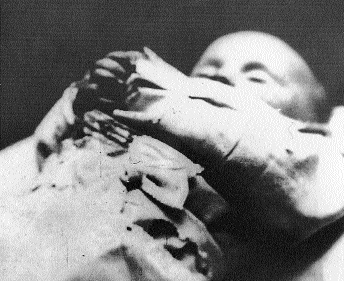
An infant victim of the Belfast violence c. 1922. Bishop MacRory laid the blame on ‘the doctrine of vicarious punishment according to which the Catholics of Belfast are made to suffer for the sins of their brethren elsewhere’. (George Morrison)
Despite the small scale of the Clones affray and the fact that it is now almost forgotten, at the time it threatened to spark off a major confrontation between North and South. The first ominous move in this rapid escalation was the immediate suspension of British troop evacuations from the Free State and the intensification of violence on the border between the IRA and the USC. James Craig, the Northern premier, demanded permission from Churchill to send 5000 troops over the border to rescue the kidnapped loyalists and to occupy a portion of Free State territory for each loyalist still held in the South. Churchill, worried over the rapid escalation of the situation and fearful for the stability of the Provisional Government in the South if such an invasion took place, refused the request outright.
In order to appease Craig, three extra battalions of British troops were sent to the North and a border commission was established on 16 February to act as an ad-hoc peace-keeping agency offering arbitration in any future border disputes. The commission itself achieved very little and eventually faded out of existence by the end of April. A British officer claimed that one of the Specials told him that they had received orders to fire on any vehicle flying the border commission’s blue and white flag. General Macready, commander-in-chief of British forces in Ireland, was sceptical from the start:
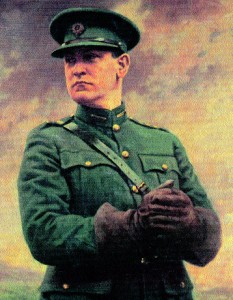
Michael Collins – his failure to understand the Northern situation meant that his policy was at best a failure and at worst counterproductive. (OPW)
‘To those who knew anything of the two component parts of the commission, the IRA and Ulster representatives, the scheme was foredoomed to failure, though no doubt it looked very attractive in Whitehall. From the first, in spite of the loyal efforts of the British officers, the whole affair was a farce.’
On 21 February the British, in a final attempt to solve the impasse, released the Monaghan prisoners from Derry Gaol, whilst the IRA responded by allowing 26 of the captured loyalists to go free. After careful diplomacy all prisoners captured since January were released and the evacuation of British troops from the Curragh resumed on 27 February. The feared confrontation had been averted.
Sectarian clashes in Belfast
However, the real victims of the Clones affray were the people of Belfast, particularly Catholics. Between 6 and 25 February 43 people were killed there (27 Catholics and 16 Protestants). Thirty-one of these deaths occurred between 13 and 15 February. The deaths included the horrific bombing in Weaver Street, where on 13 February a bomb was thrown into a Catholic schoolyard in the York Road area of the city. Two children were killed instantly; four others died later from their wounds in hospital. Father John Hassan called it ‘a more horrible outrage than any that had hitherto disgraced this savage city’. Churchill agreed, saying in the Commons that ‘It is the worst thing that has happened in Ireland in the last three years’.
Other horrors were to follow the next day. A nineteen-year-old Catholic man, James Rice, was attacked by a mob at 9pm in Ravenscroft Street. His hands were tied behind his back and he was shot several times whilst on the ground. His attackers then battered his skull in with revolver butts for good measure. His mangled body was found dumped in an alley a few hours later. Bishop MacRory later blamed the Belfast violence on ‘the doctrine of vicarious punishment according to which the Catholics of Belfast are made to suffer for the sins of their brethren elsewhere’. Throughout 1922 this pattern of border violence provoking costly sectarian clashes in Belfast was to be repeated many times. These events were further fuelled by the emotive funerals of the four Specials killed at Clones, all of which took place on 14 February in various parts of the North. On 21 February the IRA added another victim to the rapidly growing list when they shot dead another Special, 21-year-old Hector Stewart, in Edlingham Street, Belfast. The Clones affray’s list of victims had reached almost 40 within only three days of the incident.
With the onset of even more gruesome violence in Belfast during March, including the horrific MacMahon murders, the Clones affray began to appear as only a minor border skirmish of little lasting consequence. During March 53 more people were to be killed in the North. The Clones affray became just one of countless brutal incidents whose seemingly relentless increase paved the way for one final attempt to resolve the Northern issue in the shape of the second Craig–Collins pact.
Conspiracy of silence?
Despite its evident importance at the time, the Clones affray has been almost forgotten. This is bound up with the broader attitudes to the establishment of Northern Ireland. The ambiguities and brutality of the conflict in the North resulted in almost a conspiracy of silence, both sides having a vested interest in leaving such events where they lay. This has remained the case despite the fact that almost 500 people lost their lives in Belfast alone during the 1920–22 period, the highest per capita total in Ireland during the whole revolutionary period. Critiques of the establishment of the Northern Ireland state inevitably focus on unionists’ use of oppressive security measures and involvement in brutal acts of repression and murder. For Southern nationalists the Northern situation is a sorry tale of miscalculation, culminating in the shambolic Boundary Commission of 1925 and the virtual abandonment of the Northern Catholic minority. They have preferred to hide behind a mantra of rhetoric on their desire for Irish unity, whilst doing little constructively to bring it about. In this sense both sides find that the period fits uneasily into their respective national stories. Unionists during this period fit more readily the role of besiegers of the Catholic minority rather than the besieged of old, whilst nationalists prefer to concentrate on the less morally ambiguous victory they obtained over the British in the War of Independence rather than the squalid failure in the North.
The Clones affray also illustrates the shadowy and confused role of Michael Collins, who, stuck in his cocoon of conspiracy, continued in his deluded belief that an aggressive IRA policy could achieve similar results to those of the War of Independence. His failure to understand the Northern situation meant that his policy was at best a failure and at worst counterproductive, doing little else but confirming unionist prejudices and highlighting the Northern Catholic minority’s vulnerability. The Clones affray signalled neither the end nor the beginning of a new phase in North–South relations: it was a tragic accident that never should have happened.
Robert Lynch is a PhD student in the Department of History at the University of Stirling, Scotland.
Further reading
T.P. Coogan, Michael Collins (Nottingham, 1991).
M.A. Hopkinson, Green against Green: the Irish Civil War (Dublin, 1988).
J. McDermott, Northern Divisions: The Old IRA and the Belfast Pogrom (Belfast, 2001).
E. Phoenix, Northern nationalism: nationalist politics, partition and the Catholic minority in Northern Ireland 1890–1940 (Belfast, 1994).
















